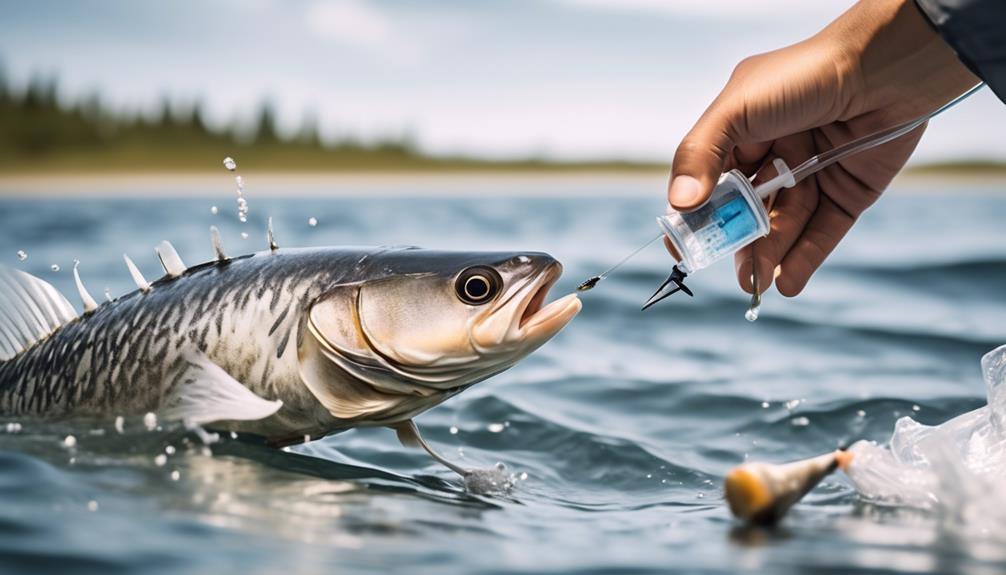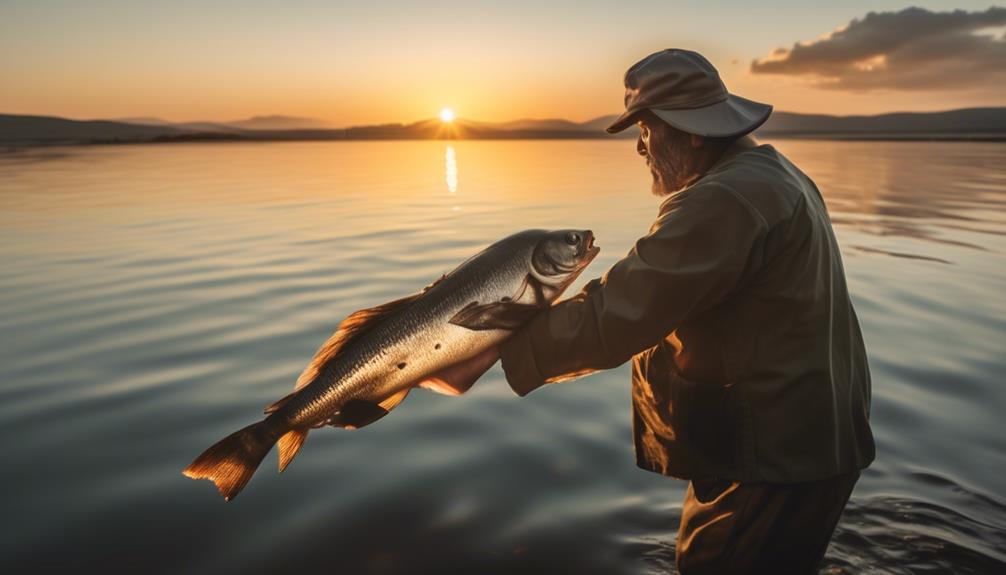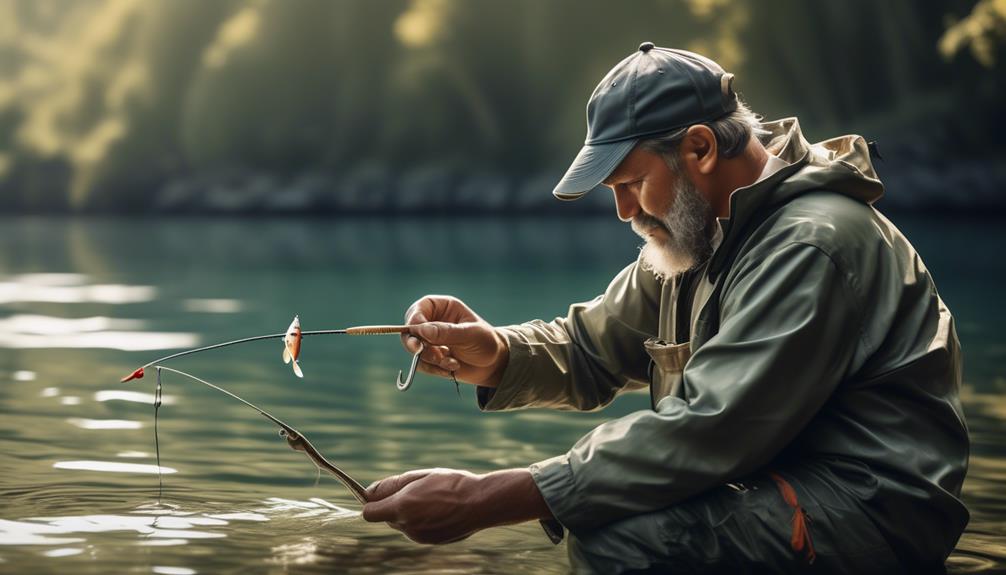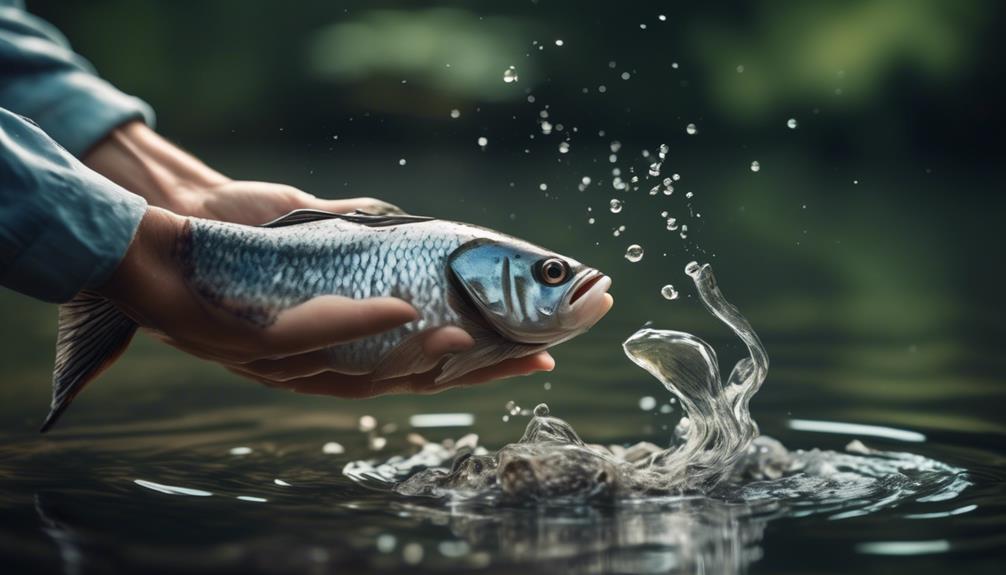When it comes to the catch and release ethics debate, it's like navigating uncharted waters – there are multiple viewpoints to consider and weigh.
As an angler, conservationist, or someone interested in ethical considerations, the perspectives on this matter are diverse and often conflicting.
The impact on fish populations, legal and regulatory aspects, and the angler's responsibility are just a few aspects to consider.
So, where do you stand in this ongoing debate, and what are the best perspectives to consider?
Traditional Angler's Perspective
When considering catch and release ethics, traditional anglers hold the viewpoint that the practice aligns with their values of conservation and sportsmanship. For traditional anglers, the experience of fishing extends beyond the mere act of catching a fish; it encompasses an appreciation for nature and a commitment to preserving fish populations for future generations. Their fishing techniques often involve using barbless hooks to minimize harm to the fish, as well as employing proper handling and release methods to ensure the fish has the best chance of survival after being caught.
The angler's experience is deeply rooted in the connection to the natural world and the thrill of the chase. For traditional anglers, it's not just about the size or quantity of the catch, but also about the skill and patience required to lure the fish and successfully reel it in. They take pride in honing their fishing techniques and understanding the behaviors of different fish species, making the catch and release process a fulfilling and educational endeavor.
Furthermore, traditional anglers often view catch and release as a means of contributing to the conservation of fish populations. By releasing the fish back into the water, they're actively participating in the sustainability of the ecosystem and ensuring that future generations of anglers can also enjoy the sport. This aligns with their values of sportsmanship, as they strive to maintain a healthy balance between their enjoyment of fishing and their responsibility to protect the environment.
Conservationist's Viewpoint
From a conservationist's viewpoint, catch and release practices are seen as essential for maintaining the balance of aquatic ecosystems. Wildlife management and sustainability practices are at the core of conservation efforts. By releasing fish back into their natural habitat, anglers contribute to the preservation of fish populations, helping to maintain healthy ecosystems. This is crucial for the overall sustainability of aquatic environments.
Conservationists advocate for catch and release as a means of ecosystem preservation and animal welfare. When done responsibly, catch and release can minimize the impact on fish populations, allowing them to thrive and contribute to the ecological balance. It supports biodiversity and helps prevent the depletion of fish stocks.
Furthermore, catch and release aligns with the principles of wildlife management. It allows for the enjoyment of recreational fishing while minimizing harm to fish populations. This practice promotes ethical and sustainable angling, ensuring that future generations can continue to engage in the sport.
Conservationists also emphasize the importance of handling fish with care during catch and release. By using proper techniques and minimizing stress on the fish, anglers can enhance the likelihood of survival upon release. This approach underscores the commitment to animal welfare and ethical treatment of wildlife.
Ethical Considerations
Considering the impact of catch and release practices on fish welfare is essential for ethical angling. When engaging in catch and release fishing, it's crucial to take into account the welfare of the fish. Ethical dilemmas arise when anglers debate whether catch and release practices truly benefit the well-being of the fish. The concept of animal welfare comes into play, as anglers must weigh the potential stress and harm caused to the fish against the benefits of conservation and preserving fish populations.
A key ethical consideration is the potential stress and injury experienced by fish during catch and release. While many fish may swim away seemingly unharmed, the act of being hooked, reeled in, and handled can still cause significant stress and physical harm. This raises the ethical question of whether the benefits of catch and release, such as conservation and sustainability, outweigh the potential negative impact on individual fish.
Additionally, the duration of the fight and handling time, as well as the use of barbless hooks and proper handling techniques, must be carefully considered to minimize harm to the fish. As an ethical angler, it's important to stay informed about best practices for reducing the impact of catch and release on fish welfare.
Ultimately, ethical considerations in catch and release fishing require a thoughtful balance between conservation efforts and the well-being of individual fish.
Impact on Fish Population
Minimizing the impact on fish populations while practicing catch and release fishing requires careful consideration of sustainable angling practices. When engaging in catch and release fishing, it's essential to be mindful of the potential impact on fish populations and the overall ecosystem health.
Here are some key points to consider:
- Fish Stress: When fish are caught and released, they experience stress and exhaustion. This can weaken their immune systems and make them more susceptible to diseases, ultimately affecting their population.
- Survival Rates: Research shows that the survival rates of caught and released fish can vary depending on factors such as handling techniques, hook type, and environmental conditions. Understanding these factors is crucial to minimizing the impact on fish populations.
- Selectivity: Practicing selective harvest by targeting non-native or invasive species for catch and release can help in preserving the native fish population and maintaining the balance within the ecosystem.
- Wildlife Management: Implementing catch and release regulations based on scientific data and wildlife management strategies can contribute to sustainable fish populations, ensuring that future generations can also enjoy the sport of fishing.
Legal and Regulatory Aspects
When engaging in catch and release fishing, it's important to understand the legal and regulatory aspects that govern these practices to ensure the sustainability of fish populations and the overall ecosystem health. Compliance with regulations is crucial to uphold ethical considerations and ensure the well-being of aquatic environments. Legal obligations pertaining to catch and release fishing are designed to minimize the environmental impact and promote responsible angling practices.
Compliance with regulations is essential to maintain the ethical considerations of catch and release fishing. By adhering to specific guidelines, such as size and species restrictions, anglers can contribute to the preservation of fish populations. Additionally, understanding and following local fishing regulations help in safeguarding sensitive ecosystems and promoting ethical behavior towards aquatic life.
Legal obligations play a significant role in mitigating the environmental impact of catch and release fishing. These obligations often include rules regarding the use of barbless hooks, proper handling techniques, and the prohibition of certain fishing practices in designated areas. Adhering to these legal requirements not only minimizes harm to fish but also contributes to the overall conservation of aquatic habitats.
Angler's Responsibility
As an angler, you have a responsibility to ensure the proper handling and release of fish during catch and release fishing, contributing to the preservation of aquatic ecosystems. Your ethical obligations extend beyond the legal requirements and encompass a commitment to the well-being of the fish and the sustainability of their habitats.
To fulfill this responsibility, consider the following:
- Proper Handling Techniques: When catching and releasing fish, use barbless hooks, handle them with wet hands or gloves to protect their slime coat, and minimize air exposure to prevent stress and injury.
- Use of Suitable Gear: Employ appropriate fishing gear such as rods, lines, and hooks that match the targeted fish species to reduce injury and facilitate a smooth release process.
- Education and Awareness: Stay informed about the best catch and release practices and share this knowledge with fellow anglers. Educating others about the importance of responsible fishing contributes to collective efforts in wildlife management and conservation.
- Habitat Protection: Recognize that your actions as an angler can impact the aquatic environment. Avoid damaging sensitive habitats and be mindful of wildlife management guidelines to minimize your ecological footprint.
Scientific Research and Findings

To better understand the impacts of catch and release fishing on fish populations and ecosystems, researchers have conducted numerous studies and experiments. These efforts have provided valuable insights into the effects of catch and release on animal welfare and habitats protection.
Studies have shown that while catch and release fishing can lead to some stress for fish, when handled properly and released quickly, the majority of fish survive and resume normal activities. With advances in technology, researchers have been able to track the post-release movements and behaviors of fish, further confirming the overall survival and well-being of the released fish.
Furthermore, scientific research has also emphasized the importance of protecting habitats in conjunction with catch and release practices. Healthy habitats are critical for fish populations, and sustaining these habitats is essential for the long-term success of catch and release strategies.
Studies have highlighted the significance of maintaining water quality, preserving spawning areas, and minimizing habitat destruction to support thriving fish populations.
Environmental Implications
Building on the insights gained from scientific research on catch and release fishing's impacts, we can now examine the environmental implications of these practices. It's crucial to understand the wider effects on wildlife management, ecosystem health, biodiversity conservation, and habitat preservation.
- Wildlife Management: Catch and release fishing can play a significant role in wildlife management by helping to maintain balanced fish populations. By releasing fish back into their natural habitat, anglers contribute to sustainable fish stocks, which in turn can support the overall health of aquatic ecosystems.
- Ecosystem Health: The practice of catch and release fishing can contribute to the overall health of ecosystems. By returning fish to their environment, anglers help maintain the natural balance of predator-prey relationships and nutrient cycling within aquatic systems. This can have positive ripple effects throughout the entire ecosystem.
- Biodiversity Conservation: Catch and release fishing can contribute to biodiversity conservation efforts. By allowing fish populations to thrive, anglers can help preserve the diversity of species within a given habitat, which is crucial for maintaining healthy and resilient ecosystems.
- Habitat Preservation: By releasing fish back into their natural environment, anglers can help preserve the habitats that support diverse aquatic life. Healthy fish populations indicate a well-preserved habitat, and by practicing catch and release, anglers can play a role in maintaining these vital environments.
Understanding the environmental implications of catch and release fishing is essential for promoting sustainable angling practices and contributing to the overall health of aquatic ecosystems.
Frequently Asked Questions
How Does Catch and Release Impact the Mental and Physical Well-Being of the Fish?
Catch and release can lead to mental stress and physical injury for fish. This practice affects their well-being and raises ethical considerations. However, it also supports conservation efforts by promoting sustainable fishing practices.
It's important to consider the impact on fish and make informed decisions to minimize harm while enjoying the sport. Conservation organizations and anglers are working together to find a balance between ethical fishing practices and the well-being of fish.
What Are the Potential Economic Impacts of Catch and Release on Local Communities and Businesses?
Catch and release fishing can have significant economic impact on local communities and businesses. It can boost tourism, increase demand for fishing gear and equipment, and support related service industries. As a result, it contributes to business sustainability and stimulates economic growth.
Additionally, catch and release aligns with conservation efforts, helping to maintain fish populations and preserve the natural environment, which in turn can attract more visitors and benefit local economies.
Are There Any Cultural or Historical Perspectives on Catch and Release That Should Be Considered?
When considering cultural traditions, it's important to recognize the long-standing practices of catch and release in various communities. Many cultures have embraced the concept of respecting nature and preserving fish populations through this method.
Additionally, catch and release aligns with environmental conservation efforts, promoting sustainability and the protection of aquatic ecosystems. Understanding these cultural and environmental perspectives can provide valuable insights into the ethics of catch and release.
How Does Catch and Release Affect the Overall Ecosystem Beyond Just Fish Populations?
Catch and release can have significant ecosystem effects beyond just fish populations. By reducing the mortality of targeted fish species, it can help maintain biodiversity and conserve the overall ecosystem.
When done responsibly, catch and release can contribute to the sustainability of fish populations and the health of their habitats. It allows for the continuation of diverse aquatic ecosystems, supporting the various species that rely on them for survival.
What Are the Potential Long-Term Effects of Catch and Release on Fish Behavior and Genetics?
Catch and release can impact fish genetics by favoring traits that make them more likely to survive catch and release scenarios. This could potentially alter the genetic makeup of fish populations over time.
In terms of behavior modification, repeated exposure to catch and release practices may cause fish to become more wary or less likely to strike at bait, affecting the overall fishing experience.
Conclusion
In conclusion, considering the various perspectives on catch and release ethics, it's important for anglers to be mindful of their impact on fish populations and the environment.
By understanding the ethical considerations, legal regulations, and scientific research, anglers can responsibly practice catch and release.
Ultimately, the goal is to conserve fish populations and ensure sustainable fishing practices for future generations to enjoy.



